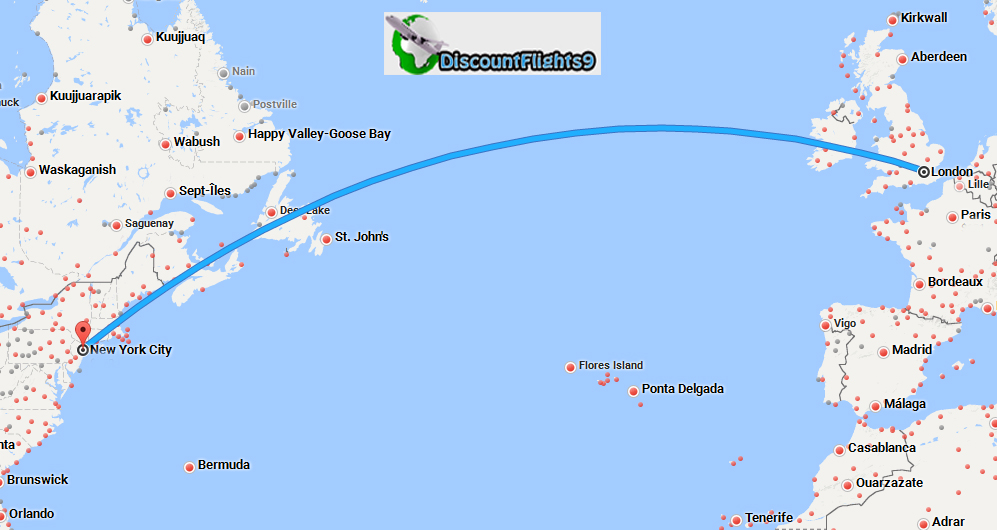When planning a trip from New York to London, understanding the flight distance is crucial for travelers. The distance between these two iconic cities not only influences the duration of your flight but also impacts your travel itinerary and overall experience. In this article, we will delve into the specifics of the New York to London flight distance, the factors that affect it, and what travelers can expect on their journey.
The distance from New York to London is approximately 3,459 miles (5,570 kilometers) when flying directly. However, this figure may vary slightly depending on the flight path taken by the airline. As one of the most popular international routes, numerous airlines operate flights between these two bustling metropolises, making it essential for travelers to be informed about their options.
Additionally, understanding the flight distance can help you make better decisions regarding your travel plans. Whether you're flying for business or leisure, knowing the duration and distance of your flight can help you prepare for your journey, manage your time effectively, and enhance your overall travel experience.
Table of Contents
- Flight Distance from New York to London
- Factors Affecting Flight Distance
- Average Flight Duration
- Airlines Operating on the Route
- Airports in New York and London
- Tips for a Comfortable Flight
- Travel Requirements
- Conclusion
Flight Distance from New York to London
The flight distance from New York to London is approximately 3,459 miles (5,570 kilometers). This distance is based on a direct flight path, which is typically the most efficient route. However, it is essential to note that the actual distance may vary slightly due to factors such as weather conditions and air traffic control regulations.
The Great Circle Route
Most airlines utilize the Great Circle route, which is the shortest distance between two points on the surface of a sphere. This method ensures that flights are as efficient as possible, minimizing travel time and fuel consumption. The Great Circle distance from New York to London is about 3,459 miles, making it a preferred choice for airlines operating on this route.
Factors Affecting Flight Distance
Several factors can influence the flight distance from New York to London. Understanding these factors can help travelers anticipate variations in their travel plans.
- Weather Conditions: Adverse weather conditions, such as storms or strong winds, may force airlines to adjust their flight paths, potentially increasing the distance.
- Air Traffic Control: Congestion in air traffic can lead to longer flight paths as pilots must avoid busy airspace.
- Airline Routing: Different airlines may take slightly different routes based on their operational protocols, affecting the overall distance.
- Flight Altitude: Depending on the altitude at which the flight operates, the distance covered can vary slightly.
Average Flight Duration
The average flight duration from New York to London is approximately 7 to 8 hours. This duration can vary based on several factors, including:
- Flight Path: As mentioned earlier, the flight path can affect the duration. Direct flights will be faster compared to those with layovers.
- Wind Conditions: Tailwinds can reduce flight time, while headwinds can prolong it.
- Aircraft Type: Different aircraft have varying speeds, impacting overall flight duration.
Airlines Operating on the Route
Several reputable airlines operate flights from New York to London. Some of the major carriers include:
- British Airways
- American Airlines
- Delta Air Lines
- Virgin Atlantic
- United Airlines
Each airline offers a range of services and amenities, making it essential for travelers to consider their preferences when booking flights.
Airports in New York and London
Travelers flying from New York to London typically depart from one of the city’s major airports:
- John F. Kennedy International Airport (JFK): Located in Queens, JFK is the primary international airport serving New York City and handles the majority of international flights.
- Newark Liberty International Airport (EWR): Located in Newark, New Jersey, EWR is another major international gateway for travelers heading to London.
- LaGuardia Airport (LGA): While primarily serving domestic flights, LaGuardia also offers limited international services.
Upon arrival in London, travelers typically land at one of the following airports:
- Heathrow Airport (LHR): The primary airport for international flights, Heathrow is located west of Central London.
- Gatwick Airport (LGW): Located to the south of London, Gatwick also serves a significant number of international flights.
Tips for a Comfortable Flight
To enhance your travel experience from New York to London, consider the following tips:
- Choose Your Seat Wisely: Opt for a seat that suits your preferences, whether you prefer window or aisle seats.
- Stay Hydrated: Drink plenty of water during the flight to combat dehydration, which can occur in the cabin environment.
- Bring Entertainment: Download movies, books, or music to keep yourself entertained during the flight.
- Adjust Your Sleep Schedule: Try to adjust your sleep schedule a few days before your flight to minimize jet lag.
Travel Requirements
Before traveling from New York to London, it’s essential to be aware of the travel requirements:
- Passport: Ensure your passport is valid for at least six months beyond your intended departure date.
- Visa: Check if you require a visa to enter the United Kingdom based on your nationality.
- Health and Safety Regulations: Be informed about any health and safety regulations, including vaccination requirements.
Conclusion
In conclusion, understanding the flight distance from New York to London is vital for planning your journey. With a distance of approximately 3,459 miles and an average flight duration of 7 to 8 hours, travelers can prepare accordingly. By considering factors such as airlines, airports, and travel requirements, you can ensure a smooth and enjoyable travel experience. If you have any questions or would like to share your travel experiences, feel free to leave a comment below!
We invite you to explore more articles on our site for additional travel tips and insights. Safe travels!


![[Download 24+] Passenger Ship New York To London](https://i2.wp.com/www.tripsavvy.com/thmb/6UTVeM595mZZd81taBKjyJpm86I=/1500x1000/filters:no_upscale():max_bytes(150000):strip_icc()/how-to-travel-from-new-york-to-london-4800604_color2-ac3db9975d0740c7a3dd366dd36953b6.gif)

